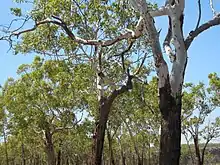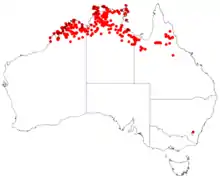Eucalyptus miniata
Eucalyptus miniata, commonly known as the Darwin woollybutt[2] or woolewoorrng,[3] is a species of medium-sized to tall tree that is endemic to northern Australia. It has rough, fibrous, brownish bark on the trunk, smooth greyish bark above. Adult leaves are lance-shaped, the flower buds are ribbed and arranged in groups of seven, the flowers orange or scarlet and the fruit is cylindrical to barrel-shaped or urn-shaped, with ribs along the sides.
| Darwin woollybutt | |
|---|---|
 | |
| Eucalyptus miniata on the Yambarran plateau, Victoria Bonaparte | |
| Scientific classification | |
| Kingdom: | Plantae |
| Clade: | Tracheophytes |
| Clade: | Angiosperms |
| Clade: | Eudicots |
| Clade: | Rosids |
| Order: | Myrtales |
| Family: | Myrtaceae |
| Genus: | Eucalyptus |
| Species: | E. miniata |
| Binomial name | |
| Eucalyptus miniata | |
 | |
| Occurrence data from AVH | |
| Synonyms[1] | |
|
Eucalyptus aurantiaca F.Muell. | |



Description
Eucalyptus miniata is a tree that typically grows to a height of 15–25 m (49–82 ft), sometimes as tall as 30 m (98 ft), usually with a single trunk, and forms a lignotuber. The bark is soft, rough, fibrous and fissured, grey to red-yellow-brown in colour on the trunk with white to pale grey smooth bark on the upper trunk and branches. Young plants and coppice regrowth have greenish-brown leaves that are elliptical in shape, 30–60 mm (1.2–2.4 in) long and 20–30 mm (0.79–1.18 in) wide. Adult leaves are dull to slightly glossy green, paler on the lower surface, lance-shaped to curved, 75–150 mm (3.0–5.9 in) long and 25–50 mm (0.98–1.97 in) wide. tapering to a petiole 12–27 mm (0.47–1.06 in) long.[4][5]
The flower buds are arranged in groups of seven on an unbranched peduncle 10–35 mm (0.39–1.38 in) long, the individual buds sessile or on pedicles up to 7 mm (0.28 in) long. Mature buds are club-shaped, rarely spindle-shaped, glaucous, 10–23 mm (0.39–0.91 in) long and 9–12 mm (0.35–0.47 in) wide with ribs along the sides and a rounded to conical operculum. Flowering occurs from May to September and the flowers are orange or scarlet and up to 35 mm (1.4 in) in diameter. The fruits are woody, cylindrical to barrel-shaped or urn-shaped capsules 33–60 mm (1.3–2.4 in) long, 20–40 mm (0.79–1.57 in) wide and have longitudinal ribbing with the valves enclosed below the level of the rim. The fruits are glaucous at first but lose that covering over time and contain seeds that are dark grey to black, 5–7 mm (0.20–0.28 in) long with an obliquely pyramidal to flattened cuboid shape.[4][5][6]
Taxonomy and naming
The species was first formally described by the botanist Johannes Conrad Schauer in 1843 in Wilhelm Gerhard Walpers work Repertorium Botanices Systematicae from an unpublished description by Allan Cunningham.[7][8] The species name miniata is Latin meaning flame-scarlet referring to the colour of the filaments of the flowers.[4] The Miriwoong people of the Kimberley call the tree woolewoorrng.[3]
Distribution and habitat
Eucalyptus miniata is commonly found in open forest, savanna communities and on sandstone escarpments, growing in sandy soils. It is widely distributed from the Kimberley region in Western Australia and through northern parts of the Northern Territory to the Burketown region of far northwestern Queensland. It occurs in the Arnhem Coast, Arnhem Plateau, Central Kimberley, Daly Basin, Darwin Coastal, Einasleigh Uplands, Gulf Coastal, Gulf Fall and Uplands, Gulf Plains, Northern Kimberley, Ord Victoria Plain, Pine Creek, Tiwi Cobourg, and Victoria Bonaparte bioregions.[2][4][5][6][9]
Ecology
Red-tailed black cockatoos living in the north of Australia prefer feeding on the Darwin woollybutt.[6]
Conservation status
Eucalyptus miniata is classified as "not threatened" in Western Australia by the Western Australian Government Department of Parks and Wildlife.[2]
.jpg.webp) flowers on a tree near Humpty Doo
flowers on a tree near Humpty Doo_(20165942804).jpg.webp) illustration from Eucalyptographia
illustration from Eucalyptographia
See also
References
- "Eucalyptus miniata". Australian Plant Census. Retrieved 8 November 2019.
- "Eucalyptus miniata". FloraBase. Western Australian Government Department of Biodiversity, Conservation and Attractions.
- Mirima Dawang Woorlab-gerring Language and Culture Centre. (2017) Miriwoong Woorlang Yawoorroonga-woorr - a Miriwoong Lexicon for all. Kununurra, Western Australia.
- "Eucalyptus miniata". Centre for Australian National Biodiversity Research. Retrieved 31 May 2020.
- Chippendale, George M. "Eucalyptus miniata". Australian Biological Resources Study, Department of the Environment and Energy, Canberra. Retrieved 8 November 2019.
- Elliot, Rodger W.; Jones, David L.; Blake, Trevor (1992). Encyclopaedia of Australian Plants Suitable for Cultivation: Vol. 4: Eu-Go. Port Melbourne: Lothian Press. p. 148. ISBN 0-85091-213-X.
- "Eucalyptus miniata". APNI. Retrieved 8 November 2019.
- Schauer, J.C. in Walpers, W.G. (1843), Repertorium Botanices Systematicae 2(5): 925. Retrieved 7 July 2018.
- NT Flora Northern Territory Flora online Eucalyptus miniata factsheet. Retrieved 11 June 2018